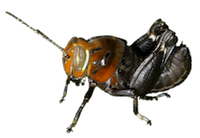| |
Family (Alpha): | |
| View | Acrididae Members:
| NC Records |
|---|
Melanoplus acrophilus Hebard, 1935 - Peak-loving Green-legged Melanoplus |

Male |
|
|
|
|
|
Image Gallery for Melanoplus acrophilus - Peak-loving Green-legged Melanoplus
|
 | Recorded by: E. Corey, J. Lynch
Watauga Co.
Comment: |  | Recorded by: B.B. Fulton
Yancey Co.
Comment: NCSU Insect Museum specimen. Internal reproductive structures were dissected and are partially exposed |
 | Recorded by: B.B. Fulton
Yancey Co.
Comment: NCSU Insect Museum specimen |

 »
»
 »
»